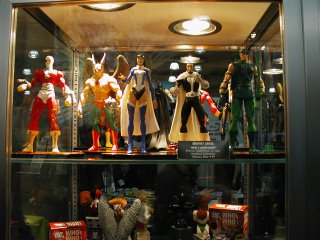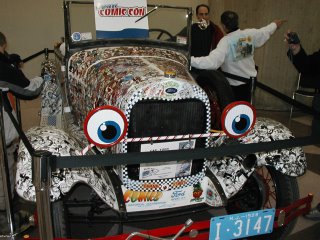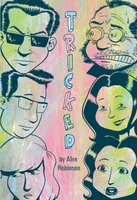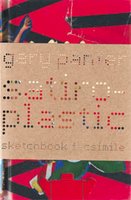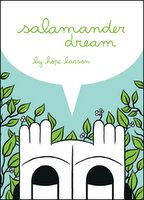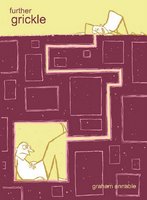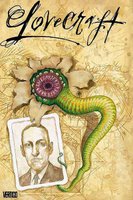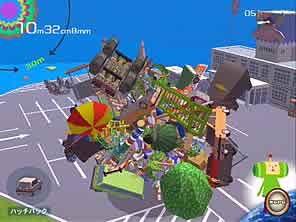A manga for all seasons
First off, I call your attention to the Associated Press, which did an odd photo/cartoon thingy of the NYCC. It's full of the usual insulting cliches about comic and manga fans and fixates a little too much on the old-school boys club mentality. I saw plenty of grown women at the show too, folks. Anyway, you can read the piece here.
OK, moving on. Here is the full, unexpagated version of the manga/anime story that ran in the Arts & Leisure section of the Patriot-News last Sunday. Corrections due to my own utter ineptness have been duly made. The photos below are of the Cedar Cliff High School Anime Club at Riot! and were taken by Patriot-News photographer Sean Simmers (and are obviously copyrighted by The Patriot-News, 2006).
If all goes well, I'll post the side story here tomorrow.

It’s Wednesday night, and Cedar Cliff High School’s Anime Club has gathered at RIOT! Comics + Culture in Lower Allen Twp. for its weekly meeting.
As the latest episode of the anime "Cromartie High School" plays on the television, the club members talk passionately about their hobby, their voices rising with excitement as they discuss which convention they might attend this year, or whether a highly touted manga (which means comic in Japanese) will finally be translated into English.
Their arms and laps are full of digest-sized black and white manga and glossy magazines, with titles like "Shojo Beat," "Fruits Basket" and "Bleach." Colorful drawings of large-eyed, spiky-haired youths grace the covers, either promising romance or high adventure.
Listening to these high schoolers talk, it’s clear they have a definite reverence for Japanese pop culture that extends far beyond the occasional Saturday morning cartoon show.
But this isn’t some small niche group. Interest in Japanese comics and cartoons has been steadily on the rise for several years now among American teens and young adults. Walk into any local Border’s or Barnes & Noble, and you’re sure to find a pack of youths sprawled along the graphic novel section, devouring books like "Chobits" and "Naruto."
According to Milton Griepp, publisher of ICV2.com, an online trade publication, manga sales grew from 55 million in 2002 to 125 million in 2004, and Griepp expects that number to be even larger when the final total comes in for 2005.
It’s not just comics and animation either. Japanese video games like the "Final Fantasy" series and "Katamari Damacy," and horror films like "The Ring" and "The Grudge" have developed strong fan support from Western audiences.
On the Internet, sites like j-list.com allow consumers to buy anything from CDs of Japanese pop stars to obscure wind-up toys to T-shirts and snacks. Type in the word "scantilation," and you’ll find scores of sites dedicated to translating and disseminating obscure or as yet unpublished manga over computer lines.
The bottom line is that, across the United States, Japanese popular culture is making huge inroads with today’s younger generations. And manga and anime are leading the charge.
"I think what we’re seeing is a cultural shift, similar to the shift 100 years ago from European [popular culture] to U.S. [culture]," Griepp said. He argues that Asian culture is quickly becoming a power to be reckoned with in the Western world.
What’s perhaps the most interesting thing about the growth of manga and anime is that it’s attracting a large number of young women, a demographic that has largely stayed away from American comics.
According to a story in the New York Times last year, girls and women account for 60 percent of manga’s readership, with the strongest market being girls ages 12-17.
This interest in Japanese culture has been slowly rising over the past 20 years or so and can be attributed to a number of influences, including the predominance of video game consoles such as the old Nintendo Entertainment System in American households.
Targeting girls
One significant factor that got the ball rolling was the arrival of cartoon shows like "Sailor Moon," and later "Pokemon," on Saturday morning television.
"The tip of the spear," said Griepp, "has been animation."
Here were shows that were decidedly different in nature from the usual cartoon fare, and that, especially in the case of "Sailor Moon," directly appealed to young girls.
"It really had a different feel to it," said Liz Coppola, vice president of sales and marketing at Viz, one of the oldest publishers of manga in the United States and known for titles like "Naruto" and "Full Metal Alchemist," among many others.
"It was cool. It stood apart from standard animation and had intricate storylines," she said.
In the late
"Suddenly girls had access to [comic] books that were targeted to them," said Lillian
Mixx did something different, though. While most manga up to this point had been "flopped" to read left to right instead of right to left, the company decided to keep the trades in their original Japanese format.
This not only kept the company’s costs down, it significantly added to the exotic nature of the manga. It’s that exoticness that remains a large part of anime’s and manga’s strong appeal.
Certainly that’s the case for the Cedar Cliff Anime Club, "especially living in central Pennsylvania, where frankly, there’s not a whole lot of foreign influence," said club Vice President Brian White, 17. "Having a slice of the outside is really nice."
Pop-friendly style
But if a quaint exoticness were the sole reason for manga’s popularity, it never would have been able to retain its popularity for as long or grow as steadily as it has. The fact is, exoticism is only half the equation.
"It’s got a really pop-friendly style," said Dirk Deppey, editor of The Comics Journal magazine, "that kids are used to from years of cartoons and video games."
More than that are the strong characters that readers can easily relate to and project themselves onto, no matter how outlandish the stories become.
"There is empowerment in manga" said Diaz-Przybyl. "These are stories about teenagers. Even with a lot of fantasy elements, the emotions seem very real and very believable."
"Sometimes I get lost inside the books and actually think I’m one of the main characters, said
It’s a big difference from American comics.
"U.S. comics are very straightforward, extremely clean-cut," said Coppola. "Manga has intricate story lines. It’s so much more in-depth and more compelling."
"They actually have more than just a half an hour plot, and they can go on, and they can develop the characters," said club member Mandy Grove, 14.
Deppey notes that, unlike most U.S. cartoons and comics, manga and anime have "concrete beginnings, middles and ends." And though a manga artist might have a team of helpers, in the end it’s solely his or her vision on display, unlike the corporate nature of, say, the average "Spider-Man" or "Superman" book.
Wide-ranging subjects
Perhaps the biggest reason for manga’s popularity is its diversity. Despite what a quick glance might suggest, manga and anime are decidedly not all alike.
Unlike most mainstream American comics, which tends to focus solely on superheroes, there are manga focusing on an endless variety of subjects.
There are sports manga, romance manga, horror manga and science-fiction manga. There are anime for young boys, anime for young girls and anime for decidedly older audiences.
There are manga about cooks, firefighters, tennis stars, art thieves, samurai and high school
The content often goes beyond good vs. evil storylines as well, and might occasionally raise a concerned parent’s eyebrow. Gender-bending, cross-dressing, characters who magically change sexual orientation and more can often be found in an average shojo, or young girls title.
There’s even a genre of manga known as shounen-ai, which deals exclusively in homosexual romance stories between pretty men. Designed exclusively for (and very popular with) young girls, such stories are usually very tame in their depiction of sex and sexuality. Which is not to say that edgier material isn’t out there.
Obviously, not all manga or anime are appropriate for younger readers. But neither is it all so
The power of manga
Even though it’s only been a few years since anime and manga crept into the mainstream, their influence is pretty easy to spot.
TV shows like "Teen Titans" show a very obvious anime look and feel, and many more cartoonists have appeared recently sporting some decided manga tropes.
The question is, now that Japanese manga and anime have attained a toehold on mainstream U.S. culture, what happens next? Is this just a fad that will fade away soon, or will it continue to grow and garner new audiences?
"I do think manga will plateau at some point," said Deppey. "I thought it would happen this year but it hasn’t yet. Manga will be around for a while though. That’ll be the most popular
Many companies are trying to take advantage of the interest before that plateauing occurs. Tokyopop, for example, is attempting to expand its core readership with it’s OEL line of "homegrown manga." That is, stories written and drawn by American fans of the medium, done in a easily discernible manga style.
Two of these OEL series, "Peach Fuzz" and "Van Von Hunter," have been picked up by Universal Press Syndicate to run in the comics section of many Sunday newspapers, beginning this year.
According to Diaz-Przybyl, papers such as the Boston Globe, the Chicago Tribune, the Los Angeles Times and more have signed onto the feature and are "really enthusiastic about trying to get kids to read the paper again."
Viz, meanwhile, has started a line of prose novels based off some of its more popular licenses like "Fullmetal Alchemist." It has also created a "Signature Line," which focuses on slightly more mature, sophisticated stories.
Even the popular romance publisher Harlequin has gotten in on the act, teaming up with Dark Horse Comics to publish a series of manga adaptations of their top titles.
Most experts agree that interest in anime and manga might level off soon — there are just too many titles and too many publishers vying for your attention for the market not to get choosier.
But that doesn’t mean that this influx of Japanese pop culture is going to go away anytime soon.
"When you think of any trend, there’s always going to be the ebbing and flowing of that trend," said anime club member Addie Simon, 16. "Right now we’re in a spike. It could very well go down again. But I don’t see it ever completely going away."
White confesses that his interest in anime has extended to him wanting to learn Japanese and perhaps get a job as a translator after he finishes school.
For these teen-agers, what started as curiosity for a cute cartoon has developed into a lifelong passion.
"If the stories stay as interesting as they are now I’ll probably read them until I am 80," Simon said.







